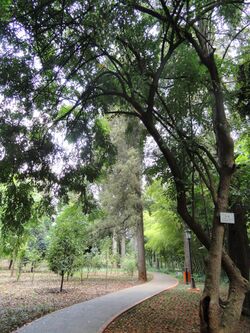Biology:Neocinnamomum
| Neocinnamomum | |
|---|---|

| |
| Neocinnamomum delavayi | |
| Scientific classification | |
| Kingdom: | Plantae |
| Clade: | Tracheophytes |
| Clade: | Angiosperms |
| Clade: | Magnoliids |
| Order: | Laurales |
| Family: | Lauraceae |
| Genus: | Neocinnamomum H.Liu |
| Species | |
|
See text | |
Neocinnamomum (新樟属, xin zhang shu) is a genus of flowering plants belonging to the family Lauraceae. They are evergreen shrubs or small trees, indigenous to Bhutan, China, India, Indonesia (Sumatra), Myanmar, Nepal, Thailand, and Vietnam. [1][2]
Neocinnamomum require a warm and wet climate with no extremes of heat and cold. They occupy mid to high elevations and montane laurel forests.[3]
Neocinnamomum leaves resemble those of true cinnamon (Cinnamomum) in possessing strongly three-veined blades, but they are arranged alternately rather than oppositely. The flowers are very small and bisexual.[2][4][5] The inflorescences are highly condensed, with poorly defined branching, their overall shape described as "glomerules".[4] Pollination is by insects.[6] The seeds are dispersed by birds, which eat the fruit which are berry-like drupes.[2] The red fruits of N. caudatum are eaten by humans.[7] The fruits are ellipsoid or globose (round). Some species also propagate vegetatively.[2]
Neocinnamomum mekongense is a species that grows in the mountains north of Dali, China. It is popular with butterflies, which possibly are attracted by secretions from extrafloral nectaries.[8]
It has been suggested that fossil flowers from the late Cretaceous of North America known as Neusenia tetrasporangi are a close match to Neocinnamomum,[9] and phylogenetic analysis from living plants might also indicate that Neocinnamomum is one of the earliest surviving lineages of the Lauraceae.[9]
Species.[1]
- Neocinnamomum caudatum (Nees) Merrill
- Neocinnamomum delavayi (Lecomte) H.Liou
- Neocinnamomum fargesii (Lecomte) Kosterm.
- Neocinnamomum lecomtei H.Liou
- Neocinnamomum mekongense (Hand.-Mazz.) Kosterm.
References
- ↑ 1.0 1.1 Flora of China online database
- ↑ 2.0 2.1 2.2 2.3 Flora of China Neocinnamomum treatment (pdf)
- ↑ 4.0 4.1 Wang, Z.-h.; Li, J.; Conran, J.; Li, H.-w. (2010). "Phylogeny of the Southeast Asian endemic genus Neocinnamomum H. Liu (Lauraceae)". Plant Systematics and Evolution 290 (1): 173–184. doi:10.1007/s00606-010-0359-1.
- ↑ Caroline K. Allen (1939). "Studies in Cinnamomum and Neocinnamomum". Journal of the Arnold Arboretum 20: 44–63. https://archive.org/stream/cbarchive_35196_studiesincinnamomumandneocinna1939/studiesincinnamomumandneocinna1939#page/n13/mode/2up.
- ↑ Susan S. Renner (2004). "Variation in diversity among Laurales, Early Cretaceous to Present". Biologiske Skrifter 55: 441–458. http://www.umsl.edu/~renners/Laurales%20clocks2005.pdf.
- ↑ "Wild edible plants used by the Garo tribes of Nokrek Biosphere Reserve, Mechalaya, India". http://nopr.niscair.res.in/bitstream/123456789/13431/1/IJTK%2011%281%29%20166-171.pdf.
- ↑ Zipcode Zoo
- ↑ 9.0 9.1 Andre S. Chanderbali; Henk van der Werff; Susanne S. Renner (2001). "Phylogeny and Historical Biogeography of Lauraceae: Evidence from the Chloroplast and Nuclear Genomes". Annals of the Missouri Botanical Garden 88 (1): 104–134. doi:10.2307/2666133. http://www.umsl.edu/~renners/Chanderbali_et_alAMBG2001.pdf.
Wikidata ☰ Q856257 entry
 |

